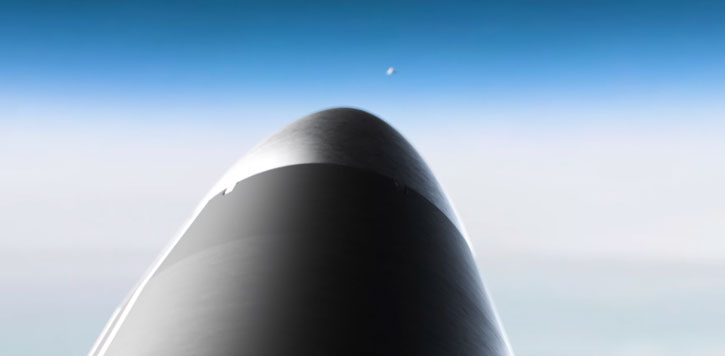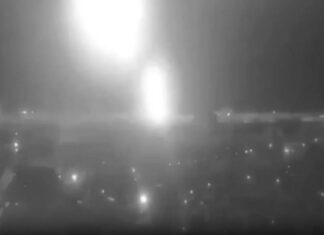RAFAEL announced today it had begun the development of a new interceptor designed specifically against hypersonic missiles. The company has been developing the new interceptor for the past three years and expects to have a prototype ready for flight testing soon. The program is funded by internal research and development investment. Still, RAFAEL is confident it can garner support for full-scale development from potential customers once the program reaches maturity level. The new interceptor, ‘ Sky Sonic,’ was introduced to media representatives today at a special presentation at RAFAEL HQ in Tel Aviv by the company’s new Chairman, Yuval Steinitz, and CEO, Yoav Har-Even. The new system will be officially unveiled at the 54th Paris Air Show, opening next week.
The Sky Sonic interceptor represents a major technological leap in hypersonic missile defense. Designed with exceptional maneuverability and high-speed capabilities, it effectively neutralizes hypersonic missiles with unmatched precision and stealth.

Hypersonic Challenges
Hypersonic missiles encompass new threats, including hypersonic atmospheric cruise missiles, gliders, and cruisers that travel at incredible speeds while maintaining exceptional accuracy and maneuverability. Unlike ballistic missiles, hypersonic missiles can change their course mid-flight. Consequently, a successful defense against hypersonic threats requires a multifaceted approach that involves countering their speed and effectively tracking, detecting, and intercepting their unpredictable flight paths.
Developing a comprehensive defensive response to hypersonic threats presents numerous complex challenges, including detection and tracking difficulties that necessitate a synchronized sensor system capable of accurately identifying and locating the threat throughout its trajectory. Furthermore, accurate trajectory prediction demands an interceptor that can swiftly reach the target, minimizing uncertainty associated with the target location. Lastly, the interceptor must exhibit exceptional maneuverability and operate on a non-ballistic trajectory to effectively pursue and neutralize the hypersonic threat.

The Sky Sonic Interceptor
The Sky Sonic interceptor is designed to integrate with existing early warning sensors and battle management suites. A two-stage missile system is designed for vertical launch and high acceleration to quickly reach the atmosphere’s edge, where hypersonic threats are expected to arrive. The first stage will bring the interceptor to the approximate height, whereas the second stage – the kill vehicle, will separate and boost further to the intercept. Both stages are fitted with fins. Company officials did not elaborate on the specific seekers or the number of sensor seekers packed into the kill vehicle. Still, the illustrations presented to the press show a distinct radome that seems to be of a different material than the kill vehicle’s body. The animation also shows blurred edges of the fins, possibly indicating the plasma created by the friction generated by the high speed of the kill vehicle. According to company officials, Sky Sonic uses advanced technologies to position the kill vehicle in a collision course with the incoming target, considering the target’s maneuvering and course changes, behavior that current interceptors cannot perform due to the inherent limitations of legacy systems. Rafael’s officials indicate that the DSWS has some capabilities to engage high-speed and maneuvering targets, but Sky Sonic will be optimized against such threats.

Officials indicated that the kill vehicle is designed for a kinetic kill but will also be effective close to its target. Sky Sonic will be able to deal with hypersonic threats flying at Mach 10 and above, either hypersonic glide vehicles (the near-term threats) or hypersonic cruise missiles expected in the future. Rafael’s Sky Sonic introduction comes a week after Iran announced its first hypersonic missile – FATTAH, which Iran claims is a hypersonic reentry vehicle with a range of 1400 km.
RAFAEL intends to offer the Sky Sonic interceptors as part of a multi-layered air and missile defense system that rely on four layers – a close-in layer aimed at counter-drone systems (C-UAS), the Low Altitude Short-Range layer protected by Spyder SR, Iron Dome, Counter Rocket, Artillery, and Mortar (C-RAM) systems, and the Iron Beam High Energy Laser System; the later will also be able to engage long range targets when they pass within the laser’s intercept range. Spyder MR protects the medium-altitude and medium-range layers. The high-altitude medium to long-range layer is protected by David’s Sling Weapon Systems (DSWS), the new Sky Sonic, designed to integrate with the DSWS and air-to-air missiles employed by combat air patrols that could also be used against incoming missiles, taking advantage of the height and forward positioning of such assets.




















